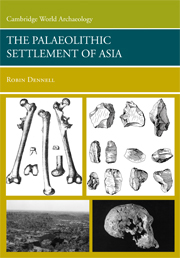Book contents
- Frontmatter
- Contents
- List of Tables, Figures, and Boxes
- Preface
- 1 Asia and Its Place in Palaeoanthropology
- 2 The African Background to the Colonisation of Asia
- 3 The Climatic and Environmental Background to Hominin Settlement in Asia before 1 MA
- 4 The Earliest Inhabitants of Southwest Asia
- 5 The Earliest Inhabitants of South and Southeast Asia and China
- 6 “Out of Africa 1” Reconsidered and the Earliest Colonisation of Asia
- 7 The Climatic and Environmental Background to Hominin Settlement in Asia between ca. 1 Ma and the Last Interglacial
- 8 The Middle Pleistocene Archaeological Record for Southwest and Central Asia
- 9 The Middle Pleistocene Archaeological Record of the Indian Subcontinent
- 10 The Middle Pleistocene Archaeological Record of China and Southeast Asia
- 11 Human Evolution in Asia during the Middle Pleistocene
- 12 Concluding Remarks
- Appendix 1 The Sizes of Countries and Regions in Asia, with Comparative Examples
- Appendix 2 Geographical Coordinates of Principal Early Palaeolithic Sites in Asia
- Appendix 3 Geographical Coordinates of Geological Sections and Cores
- Appendix 4 English Names of Various Mammals Recorded in Asia
- Bibliography
- Index
6 - “Out of Africa 1” Reconsidered and the Earliest Colonisation of Asia
Published online by Cambridge University Press: 05 June 2012
- Frontmatter
- Contents
- List of Tables, Figures, and Boxes
- Preface
- 1 Asia and Its Place in Palaeoanthropology
- 2 The African Background to the Colonisation of Asia
- 3 The Climatic and Environmental Background to Hominin Settlement in Asia before 1 MA
- 4 The Earliest Inhabitants of Southwest Asia
- 5 The Earliest Inhabitants of South and Southeast Asia and China
- 6 “Out of Africa 1” Reconsidered and the Earliest Colonisation of Asia
- 7 The Climatic and Environmental Background to Hominin Settlement in Asia between ca. 1 Ma and the Last Interglacial
- 8 The Middle Pleistocene Archaeological Record for Southwest and Central Asia
- 9 The Middle Pleistocene Archaeological Record of the Indian Subcontinent
- 10 The Middle Pleistocene Archaeological Record of China and Southeast Asia
- 11 Human Evolution in Asia during the Middle Pleistocene
- 12 Concluding Remarks
- Appendix 1 The Sizes of Countries and Regions in Asia, with Comparative Examples
- Appendix 2 Geographical Coordinates of Principal Early Palaeolithic Sites in Asia
- Appendix 3 Geographical Coordinates of Geological Sections and Cores
- Appendix 4 English Names of Various Mammals Recorded in Asia
- Bibliography
- Index
Summary
INTRODUCTION
The “Out of Africa 1” model has proved a useful way of using a very small amount of Asian evidence to explain a great deal about human evolution outside Africa in the Late Pliocene and Early Pleistocene. According to a popular formulation of this model (see, e.g., Bar-Yosef 1998a; Tattersall 1997), the genus Homo, the ability to flake stone tools and butcher large mammals, and the development of other skills needed to survive in the grasslands that were expanding in East Africa during the Late Pliocene all originated in this region (Chapter 2). Under the increasingly seasonal and arid conditions of the Late Pliocene and Early Pleistocene (Chapters 2 and 3), H. erectus s.l. emerged in East Africa as a hominin uniquely adapted to take advantage of these new conditions, and at some point colonised much of Asia. The timing of this dispersal is now estimated as ca. 1.8 Ma (see Figure 6.1), based on dates now available from Dmanisi (Chapter 4), Java, and the Nihewan Basin (Chapter 5); in the 1980s, the departure of H. erectus from Africa was dated to only ca. 1 Ma, based on the dates then available for the same sets of evidence from ⼸Ubeidiya, China, and Java. Two pieces of information that have often been highlighted in accounts of the Out of Africa model are the Nariokotome H. erectus s.l. skeleton WT 15000, dated to 1.53 Ma (Chapter 2), and the dating by Swisher et al.
- Type
- Chapter
- Information
- The Palaeolithic Settlement of Asia , pp. 186 - 202Publisher: Cambridge University PressPrint publication year: 2008



